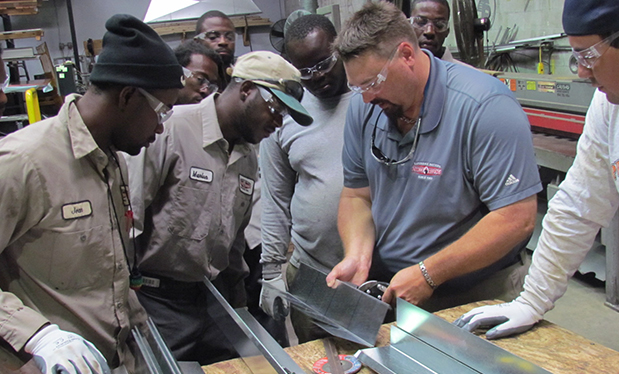The James W. Jardine Water Purification Plant in Chicago is the largest-capacity water filtration plant in the world. Located on a 60-acre peninsula on Lake Michigan and near Chicago's Navy Pier, the plant sends nearly 1 billion gallons of water every day to 5.5 million city and suburban residents.
Constructed in 1964 and operated by the city of Chicago, the plant treats 1 million gallons of fresh lake water per minute from two water cribs 2 1/2 miles offshore and pumps it to the filtration plant via 4,000 miles of pipeline under Lake Michigan. It takes eight hours from the time water gets sucked into an intake crib until it reaches a faucet somewhere in Chicagoland.
In 2012, the facility's 48-year-old gravel and coal-tar pitch built-up roof system was leaking and deteriorating at a progressive rate, posing a contamination threat to the clean water supply.
"The Jardine plant is an engineering marvel," says John Cronin, president of Trinity Roofing Service Inc., Blue Island, Ill. "But a half century of constant 80-degree temperatures with high relative humidity and chlorine processing inside the facility corroded the original roof channels."
Selected by the project's general contractor, Walsh Construction, Chicago, Trinity Roofing Service performed the 448,000-square-foot reroofing project on Chicago's most visible utility facility.
Getting started
After several months of review, submittals, engineering, setup and mobilization, the two-year roof system replacement project began in August 2012. Earlier that year, Trinity Roofing Service successfully installed a PVC roof system on the plant's twin building, but this project included several more unique challenges.
The facility is protected by the Department of Homeland Security, so all roofing personnel had to submit to criminal background checks and were granted security clearances on a daily basis.
All material deliveries were subject to inspection. The process of clearing a material delivery request usually took about 24 hours. This complicated coordination for some deliveries such as the FOAMGLAS® insulation that arrived via ship from Belgium. The insulation was stored in Trinity Roofing Service's warehouse and delivered each day as needed. The names of the material delivery drivers needed to be submitted to Walsh Construction for submittal to security 24 hours before any deliveries to the building. If there was a change in logistics, such as a change in drivers, the material was not allowed on the premises.
The load limit and weight restrictions also posed challenges. The entire facility was constructed on remnants from the Great Chicago Fire of 1871. There are vaults underneath the ground, presumably for water intake from the Carter H. Harrison and William E. Dever cribs northeast of Chicago.
To accommodate the weight restrictions, Trinity Roofing Service purchased a crane and modified it to specifically meet project parameters and restrictions and procured 4- by 12-foot crane mats for its outrigger pads to distribute the weight during hoist maneuvers. Workers also calculated the exact weight of debris that could be placed into the roll-off trucks during tear-off operations to determine the weight distribution to each axle.
Tear-off begins
The project's tear-off procedures involved several operations. First, to protect the filter beds in the building underneath the areas where crew members would work, a layer of rubber was installed in drained filter beds.
Next, more than 112,000 square feet of plywood scaffolding was erected around the 56,000-square-foot work area. Once the scaffolding was in place, a 60-mil EPDM membrane was installed by Anderson & Shah Roofing Inc., Joliet, Ill., Trinity Roofing Service's subcontractor, over the scaffolding to protect the concrete filter beds below so the plant could operate without interruptions.
Trinity Roofing Service workers then removed the existing coal-tar pitch built-up roof system. Because of weight restrictions, all tear-off debris was moved to one staging area on the roof for removal. Workers traversed more than 1,300 feet roundtrip to dump one workhorse of debris off the roof. On some days, crew members traveled more than 10 miles to transport material and debris.
Concrete pavers
Next, workers removed the 2-foot by 7-foot by 3-inch precast concrete roof deck panels each weighing 225 pounds; some specialty panels weighed more than 450 pounds. There were more than 30,000 panels on the building. Trinity Roofing Service's independent testing revealed the existing slabs were grouted at the seams with asbestos-containing roofing mastic. As a result, crews were educated about asbestos through the Chicago Roofers' Joint Apprenticeship and Training Program and received Asbestos Worker certifications to work with the material. Additionally, workers wore personal protection equipment, eyeglasses and hard hats.
To assist with removing the concrete panels, workers used a workhorse Trinity Roofing Service had built while working on the roof system of the facility's sister wing. The workhorse had been modified into a custom-built, solar-powered slab picking machine. The concrete panels were lowered to roll-off trucks via crane so they did not exceed weight restrictions and were delivered to a landfill nearly 50 miles away.
The new precast concrete roof deck panels then were installed. There were 66 types of panels among the thousands of panels to be installed, resulting in a logistical challenge to maintain inventory and prevent downtime while searching for a particular panel.
Once loaded onto the roof and transported to each installation location, the slabs were inspected by a third-party consultant appointed by the city of Chicago. Each panel had to be approved before it was installed. All rejected panels were removed from the roof and delivered to a concrete recycler.
Extensive engineering also needed to be performed on all equipment and tools to ensure the general force exerted onto the roof during typical roofing operations would not damage the newly installed panels.
"The weight restrictions led to the birth of what is probably the only five-wheeled felt machine in existence," Cronin says. "The addition of two more tires to the standard single-tire axle increased the surface area that distributed the weight of the asphalt over a greater span, minimizing the load imposed on the panels."
Workers then laid backer rod grouted with roofing mastic to fill in the equivalent of 7 miles of seams between the concrete roof deck panels and then primed all panels with asphalt primer.
A massive new roof system
Workers then began installing two plies of Type IV felt in individual moppings of hot asphalt or, weather permitting, via the five-wheel felt machine. Wood nailers at the perimeter edges and expansion joints were installed in tandem with the felt.
Next, workers laid 1 1/2-inch-thick FOAMGLAS insulation set in hot asphalt along with another two plies of Type IV felt. All 160 roof drains conformed to a unique sump design called for in drawings. A Flex FB Elvaloy® KEE 90-mil fleece-backed thermoplastic membrane then was set in hot asphalt and heat-welded at the seams.
Workers also installed all associated 80-mil flashings, detail accessories and custom-made gutters to allow for better drainage.
Adding to the seemingly never-ending challenges, Chicago's winter weather was exceptionally harsh that year. Working in subzero temperatures was a daily occurrence.
"What we learned about working on Lake Michigan is Mother Nature is the teacher and we are the students," Cronin says. "High winds and storms can change the day in 25 minutes, but even with the brutal cold and the harshest of conditions, our crew members can boast a 98 percent attendance record through one of the coldest winters on one of the toughest jobs in Chicago."
A refreshing end
Despite brutal winter conditions, Trinity Roofing Service's 35-person crew stayed the course to complete one of Chicago's most complex roofing projects. After two years of demolishing 10 acres of graveled coal-tar pitch built-up roofing material, disposing 6,100 tons of debris, installing 712,000 board feet of cellular-glass insulation, replacing thousands of precast concrete roof panels and installing 1,086 rolls of thermoplastic membrane, Trinity Roofing Service completed its work on the James W. Jardine Water Purification Plant on time.
"The most rewarding aspect of the project was watching the roof system cross the finish line on time," Cronin says. "We'll come back in 50 years to see if it needs replacing."
For its exceptional efforts, Trinity Roofing Service received a 2015 Gold Circle Award in the Outstanding Workmanship: Low-slope category.
Chrystine Elle Hanus is Professional Roofing's associate editor and NRCA's director of communications.
Project name: James W. Jardine Water Purification Plant
Project location: Chicago
Project duration: August 2012-September 2014
Roof system type: Thermoplastic KEE 90-mil fleece-backed membrane
Roofing contractor: Trinity Roofing Service Inc., Blue Island, Ill.
Roofing manufacturers: Flex Membrane International Corp., Leesport, Pa.; Pittsburgh Corning Corp.,
Pittsburgh
Gold Circle Award: Outstanding Workmanship: Low-slope category



